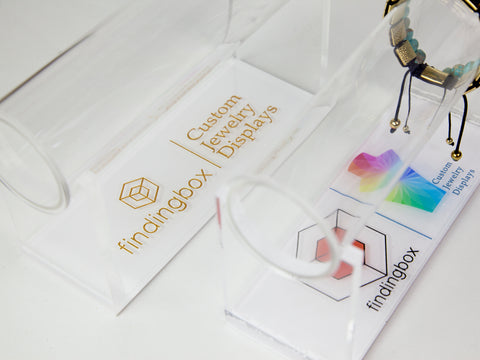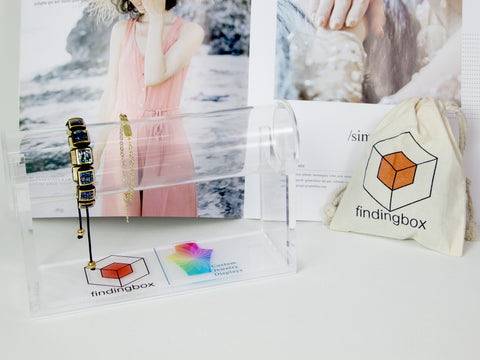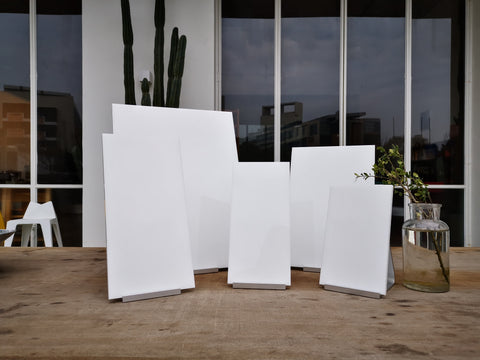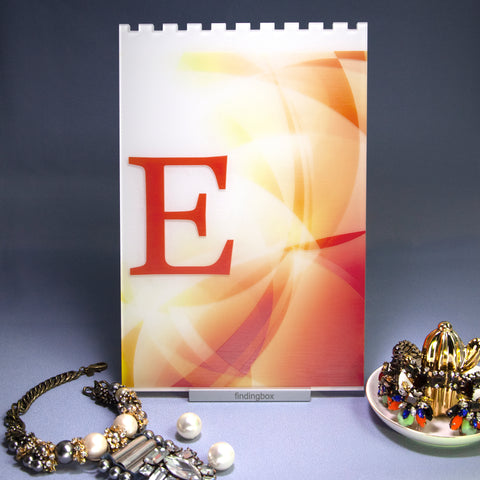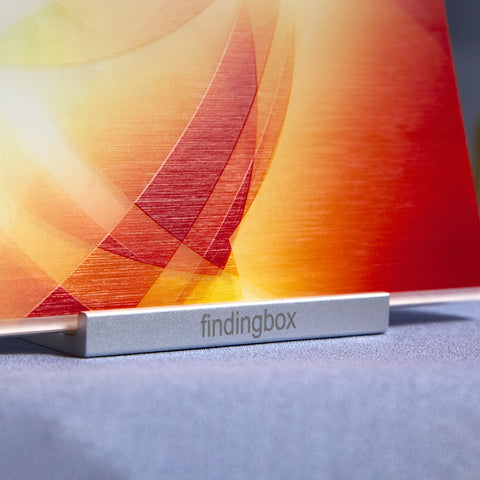
Which is the best approach within laser engraving, mechanical engraving and etching
For jewelry brands, which processing approach is the best to imprint logo or business name onto a JIBO (jewelry integrated brand object) which can be jewelry tag, bead or other finding?
If you don't like to afford a private mold and a MOQ of tens of thousands pieces for each design, basically there are three alternatives on the ground. Laser engraving, mechanical engraving and etching.
The advantage of the 3 approaches we are talking here
The common advantage of these three approaches is you don't have to make a huge quantity of the base metal component, instead you can just order a very small number. This is very valuable to a designer who has dozens or hundreds jewelry products designed in one year, and they expect a JIBO with specialized shape/ size/ color or even the type for each design. That means, the designer may need 10 different JIBOs for total 100 designs. If the designer goes to a traditional jewelry factory, he/she may be required 10K pieces of each JIBO, that's 100K pieces, or $80K+ in monetary expenses. But independent designers may not make such a quantity for a design, so most of the JIBOs may be excessive. Please be aware that it's only for the jewelry tags or beads, not the whole jewelry production.
By the 3 approaches we are talking, the designer may just spend 10% cost and order to demand instead of order to factory's MOQ terms.
Back to the title of this article, firstly we have to learn the basic methodology or working mechanism of them. Of cause, I will not explain like a physicist, actually I am not a physicist.
Mechanism of laser engraving
Laser engraving, or laser marking called in some circumstance, is the practice to leave marks on an object, which also includes color change due to chemical/molecular alteration, charring, foaming, melting, ablation, and more. It can be interpreted as the laser burns the surface of object and leaves a mark.

Mechanism of mechanical engraving
Mechanical engraving, is a machining process that consists of 'hollowing-out' the material using a diamond or tungsten steel drill. The material is removed using cutting tools, "engraving drills" of varying shapes and sizes.

Mechanism of mechanical Etching
Etching, is traditionally the process of using strong acid or mordant to cut into the unprotected parts of a metal surface to create a design in intaglio (incised) in the metal. In process of etching, a metal (usually copper or steel) object is covered with a waxy ground which is resistant to acid. Then using laser engraving to scratch off the ground where the expected artwork or letters to be marked in the finished piece, so exposing the bare metal. The plate is then dipped in a bath of acid, technically called the etchant, or has acid washed over it. The acid "bites" into the metal (it dissolves part of the metal) where it is exposed, leaving behind artwork sunk into the plate. The remaining ground is then cleaned off the object.

So far, we still be confused that which one is the best approach for JIBO. Actually, they all can be the best or worst in different circumstance. It depends on the actual demand of how the jewelry product requires a matchable effect to get a coincident tune. We will break down the effect of the 3 processes into some concrete features/ attributes.
Features of laser engraving
Laser engraving supports the most precision of design express, that means you can work with a very complicated design with many lines (or information), it can be engraved on a the tight area. But the precision of engraved mark positioning is not the best, which depends on the positioning mechanism of the machine. Findingbox adopts the best intelligent system, but it still would not assure all the products got perfect positioned engraved mark. As the object have a tolerance of the dimension, e.g. 0.1mm hight difference, that would cause the engraved mark looks different on the objects.
Laser engraving can burn into a depth of the metal surface if we use a high power output. The depth of the mark can be obviously felt by a finger touching.
Laser engraved mark can support a very thin line as the laser light dot can be very tiny small. It can engrave very small letters, even we cannot read out. The minimum font size we recommend is 10pt. So it can support the most complicated design, but it doesn't means any design. FindingBox will suggest when you upload or send us the design image.
Laser engraving has a incredible color expressing effect. The color of engraved mark can be black (deep dark), light grey (close to white) or other colors depend on the metal. E.g. if the metal base is brass, the color can be yellow like the brass, or pink on copper.
Basically, laser engraving has a most efficient processing (shortest lead time) as we can get the metal surface plated before engraving. We support plated color as gold, rose gold, silver, matte gold, matte silver, antique bronze, antique silver, gunmetal etc.
Findingbox has a sophisticated manufactory line of laser engraving, we can make 10k+ pieces daily. So the cost is very low.
Features of mechanical engraving
Versus laser engraving, mechanical engraving uses the diamond or tungsten steel drill to scratch and drill the surface of metal, the end point of the drill is about 0.3mm, so the line marked has to be thicker than 0.3mm. So the precision of design express fits the bold font letters or thick and simple image. The positioning system is good, so mechanical engraving can keep all the engraved objects looks in a same effect.
The depth of mechanical engraving looks much deeper, it's about 0.1 ~ 0.2mm drill into the metal surface.
Just like laser engraving, mechanical engraving works on the pre-plated metal, the color of engraved mark will be the same as the metal surface. That looks very neat.
The efficiency of mechanical engraving is lower, we can produce thousands pcs daily.
Features of etching
From the process of etching, we can see it's the most complicated one. It can support the same complexity of logo as laser engraving as the logo is engraved with laser as well. But as the etched metal is after-plated, the plated coating will fill the etched mark, so the lines on logo cannot be so thin.
Etching has the deepest effect, even we can make a logo hollowed on the metal tag.
The color of etched mark is as same as the metal base as it is after plated. But we can do a dual color plating to make the logo color is different to the metal base. As the process is much more complicated, the cost would be more higher than laser engraving and mechanical engraving. So as the lead time.
| Laser Engraving | Mechanical Engraving | Etching | |
| Precision | ★ ★ ★ ★ | ★ ★ ★ | ★ ★ ★ |
| Depth | ★ ★ ★ | ★ ★ ★ ★ | ★ ★ ★ ★ ★ |
| Thickness (line) | ★ ★ ★ ★ ★ | ★ ★ ★ | ★ ★ ★ ★ |
| Complexity of Design to be Marked | ★ ★ ★ ★ ★ | ★ ★ ★ | ★ ★ ★ ★ |
| Color Express | ★ ★ ★ ★ ★ | ★ ★ ★ | ★ ★ ★ |
| Metal Surface Processing | ★ ★ ★ ★ ★ | ★ ★ ★ ★★ | ★ ★ ★ |
| Lead Time | ★ ★ ★ ★ ★ | ★ ★ ★ ★ ★ | ★ ★ |
| Cost | ★ ★ ★ ★ ★ | ★ ★ ★★ | ★ ★ ★ |

